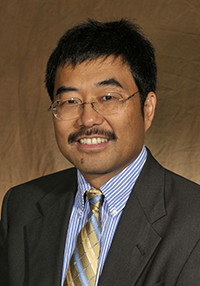Research Highlight: John Ma
Concrete Testing for Safer and More Sustainable Infrastructure

Dr. Z. John Ma, professor in the Department of Civil Engineering, leads the Tennessee Bridge Research Laboratory (TBRL) Research Group, comprised of both graduate and undergraduate students in the Structural Engineering Program at the University of Tennessee. The members of this group have a strong interest in behavior and design of prestressed concrete bridges; mechanics and applications of high performance concrete and fiber reinforced polymer composites; accelerated construction in highway bridges; sustainable structures; and evaluation of ASR-affected structures. The latter is illustrated in a unique research effort, sponsored by the US Department of Energy through ORNL’s Light Water Reactor Sustainability (LWRS) Program, located in UT’s Tickle Engineering Building.
Concrete has the potential to crack after it is poured. Alkali-silica reaction (ASR), a deleterious chemical reaction referred to as “cancer of concrete,” forms a gel substance that absorbs water and expands, ultimately creating cracks on and beneath the surface and compromising the integrity of concrete structures. All concrete structure can be affected by ASR including highways, bridges, dams, and nuclear reactors and, as such, posing a significant safety issue now and in the near future as concrete infrastructure ages.
ORNL, UTK, and a consortium of other universities have teamed up to conduct a large-scale, long-term experiment on ASR-affected concrete. The team constructed three large concrete slabs, about 136 in. long, 116 in. wide, and 40 in. thick (nuclear structures are typically at least 40 in. thick). Of the three slabs, two are reactive and can expand due to ASR, and one is a non-reactive (i.e., can’t expand due to ASR) that serves as a control sample from which all baseline measurements are taken. Of the two reactive slabs, one is confined in the horizontal directions and can only expand in the vertical direction; the other is unconfined and can expand in all directions. Each slab contains thick rebar, and each is embedded throughout with acoustic emission, pressure sensors, fiber optics, and strain transducers. The team worked with Ready Mix USA, a concrete company less than 2 miles from the research site, to pour the concrete.
It will take about two years for the concrete specimens to cure inside a large metal chamber, 52 feet long, 30 feet wide, and 12 feet high. Temperature is maintained at 100˚F and humidity at 95% to accelerate the reaction to reach critical damage at 2 years as opposed to a natural rate under normal circumstances of approximately 50 years.
One of the unique aspects of the research is that large number of monitoring sensors are involved: the sensors feed measurements, such as strain and deformation, to four different data acquisition systems. The data, along with non-destructive testing, will help determine what types of non-destructive evaluation can be conducted in the field in order to assess the damage caused by ASR in real-world concrete structures.
The project has given UT students an opportunity of a lifetime to work on a large, complex, real-world problem with a world-class research team, providing hands-on civil engineering experience and research experience. The data gleaned from this experiment will ultimately provide knowledge that contributes to safer and more sustainable engineering infrastructure.